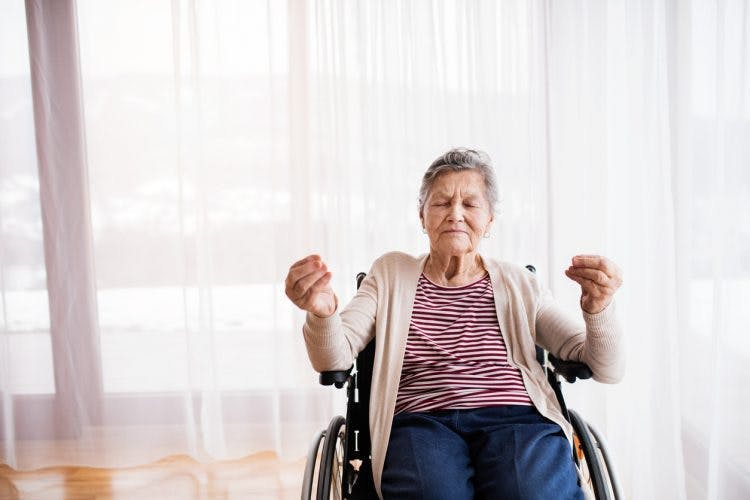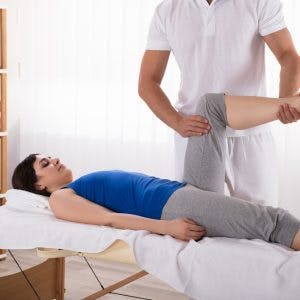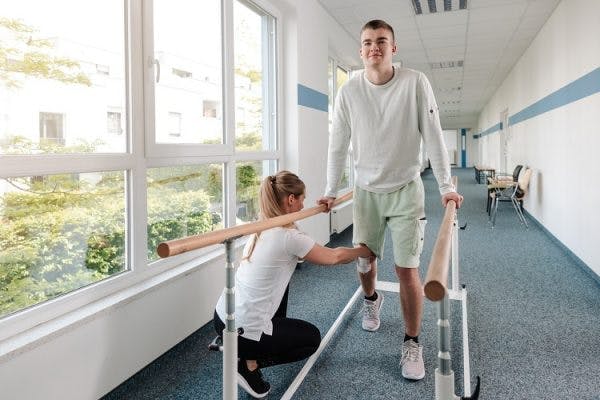After a spinal cord injury, you may feel out of sync or disconnected from your body. Yoga promotes mind-body awareness and self-acceptance, which makes it ideal for patients who are struggling to cope after spinal cord injury.
Moreover, it can be modified so individuals with motor impairments can participate and feel safe.
This article will go over the many benefits of practicing yoga for spinal cord injury rehabilitation.
Benefits of Yoga for Spinal Cord Injury
Yoga is a non-pharmacologic and cost-effective intervention with minimal risk of side effects. By adding yoga into their rehabilitation, patients can improve both their physical and mental well-being after spinal cord injury.
Benefits of yoga for spinal cord injury patients include:
- Reduced pain
- Improved mental health
- Increased circulation
- Strengthened muscles
- Improved flexibility and range of motion
- Increased metabolic rate
- Improved standing balance
- Improved respiratory function
- Greater body awareness
- Improved sleep quality
These benefits will be more thoroughly explained in the following sections.
When combined with other rehabilitation methods like physical therapy, yoga may be able to help patients improve movement and strength after spinal cord injury. This study found that, when yoga and physical therapy were combined, individuals benefitted from lower levels of stress and inflammation than individuals who solely participated in physical therapy.
Likewise, yoga may increase the production of neurotrophic factors that could help support the growth and survival of brain cells and encourage neuroplasticity. Neuroplasticity is the central nervous system’s ability to rewire itself, which plays an essential role in relearning functions affected by spinal cord injury.
Up next, we’ll discuss how yoga uses deep breathing, meditation, and physical postures to enhance spinal cord injury rehabilitation.
Deep Breathing

Deep breathing contributes to rehabilitation after spinal cord injury through several mechanisms, including increasing oxygen intake. This is important because oxygen in the blood is essential for fueling any activity that occurs in the body. When the blood is fully oxygenated, the body is more efficient and absorbs essential nutrients more quickly.
Taking short, quick breaths can trigger your body’s stress response. In contrast, deep, steady breaths will activate your body’s relaxation response, which is responsible for:
- lowering blood pressure
- increasing metabolic rate for better digestion
- stabilizes heart rate
- increasing endorphin levels in the brain to reduce pain and increase energy
As a result, deep breathing can help reduce symptoms of depression, anxiety, and post-traumatic stress after spinal cord injury.
Deep breathing techniques can also help patients with respiratory problems after SCI. Higher-level spinal cord injuries cause limitations in crucial respiratory muscles like the diaphragm, intercostal muscles, and abdominals. Practicing deep breathing exercises can help strengthen them and expand your lung capacity to breathe in more oxygen.
Meditation

Another important component of yoga for spinal cord injury patients is the practice of meditation.
Meditation is a mental component of yoga that focuses on strengthening the mind and enhancing ownership of the body. Individuals with severe spinal cord injuries may not be able to perform the various yoga positions, but they can practice meditation to improve their mental health.
It can be common to feel overwhelmed by lifestyle changes after SCI. Meditation can improve this by helping you to organize your thoughts and prioritize your recovery goals.
Guided yoga meditations emphasize:
- Self-care
- Respect for all living things
- Recognizing the blessings in everyday life
- Purity of the mind, body, and speech
- Non-possessiveness and detachment from your “image”
- Acceptance and embracing the present
By continuously meditating on these values, patients may find it easier to let go of the past and focus on their spinal cord rehabilitation. In fact, individuals who meditate regularly report improved feelings of belonging, sense of purpose, connectedness, and self-acceptance.
Postures

Yoga involves moving the body in various postures that can help lengthen tight muscles, improve range of motion in the joints, and build strength.
The goal of spinal cord injury recovery is to reteach your spinal cord, brain, and muscles how to work in sync again by consistently moving weakened areas of the body.
The postures practiced in yoga provide opportunities to repetitively move the trunk and limbs in a variety of ways. This helps prevent stiffness and stimulates the spinal cord. Likewise, consistent stretching and movement will help decrease the excitability of hyperactive muscles, which can help reduce the occurrence of spasms and pain.
Some may worry about not being able to do the poses or hurting themselves, especially if they’ve suffered a spinal cord injury. However, many yoga poses can be modified to be safe and effective for most individuals during their recovery. Because the outcomes of each spinal cord injury are different, it’s essential to work with an instructor that can guide you through the exercises and suggest safe modifications for your specific abilities.
Often, poses will be modified so that they can be performed while seated or lying down on a mat. Practicing postures in your wheelchair can be restrictive, so many instructors will encourage you to get on the floor. Not only will this expand the number of postures that you can practice, but it will also create a more stable, open base to prevent you from falling.
Check out this yoga routine designed specifically for wheelchair users!
Next, we’ll share 2 videos of SCI patients and their experiences with yoga.
Spinal Cord Injury Patients’ Yoga Experiences
Every spinal cord injury is unique, so yoga may not be ideal for all patients after an SCI; however, it’s generally a safe and low-impact workout, which makes it worth trying at least once.
Below, we’ll share the experiences of 2 spinal cord injury patients that have benefitted from practicing yoga.
First, we’ll share Kevin’s yoga experience. Kevin’s spinal cord injury resulted in paralysis of the legs and for 40 years, he was unable to feel the entire outline of his legs, until he tried yoga.
He proves that it’s never too late for recovery and that mobility can improve, even years after spinal cord injury.
Next, we’ll share Joe’s yoga experience. Joe’s C6 spinal cord injury resulted in paralysis of both the arms and legs. He started yoga because he was sick of feeling so helpless at home.
Through yoga, he has become more in-tune with his body and has improved his ability to transfer in and out of his wheelchair.
Hopefully, these 2 spinal cord injury patients helped inspire you to give yoga a try.
Yoga for Spinal Cord Injury Patients: Key Points
After a spinal cord injury, you may feel like you’re in a completely different body. Yoga can help you learn self-acceptance, cultivate mind-body awareness, and prioritize self-care.
If you’ve been having difficulties coping after spinal cord injury, consider practicing yoga. It isn’t for everyone, but it’s relatively low-risk, and its emotional, psychological, and physical benefits make it worth trying. Namaste!
Photos from top to bottom: iStock/halfpoint/AntonioGuillem/halfpoint/fizkes











